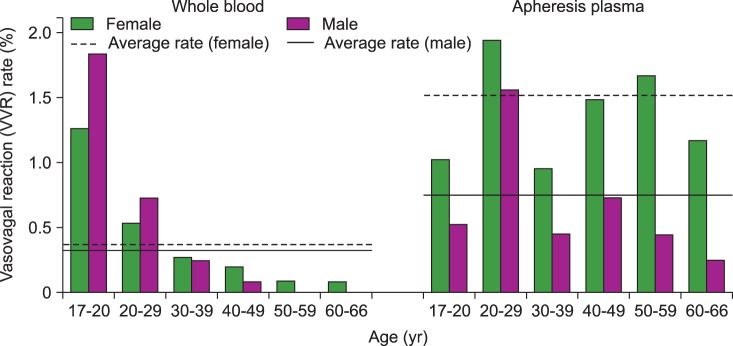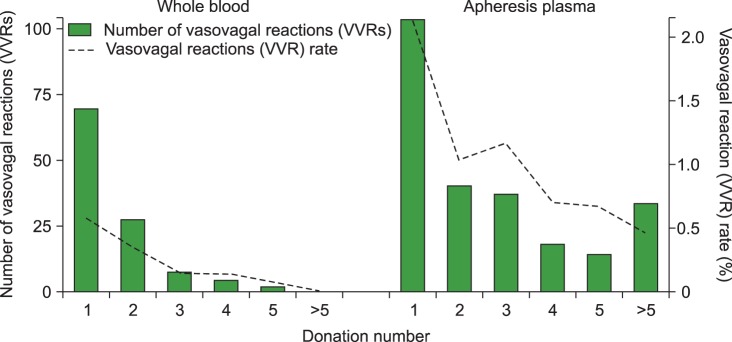Blood Res.
2016 Dec;51(4):293-296. 10.5045/br.2016.51.4.293.
Factors associated with vasovagal reactions in apheresis plasma and whole blood donors: a statistical-epidemiological study in a European donor cohort
- Affiliations
-
- 1Department of Pathology, University of Pittsburgh, Pittsburgh, PA, USA.
- 2Department of Clinical Immunology, Odense University Hospital, Odense C, Denmark. kjell.titlestad@rsyd.dk
- 3The Institute for Transfusion Medicine, Pittsburgh, PA, USA.
- KMID: 2364325
- DOI: http://doi.org/10.5045/br.2016.51.4.293
Abstract
- No abstract available.
Figure
Reference
-
1. Wiersum-Osselton JC, Marijt-van der Kreek T, Brand A, Veldhuizen I, van der Bom JG, de Kort W. Risk factors for complications in donors at first and repeat whole blood donation: a cohort study with assessment of the impact on donor return. Blood Transfus. 2014; 12(Suppl 1):s28–s36. PMID: 23867173.2. Sorensen BS, Johnsen SP, Jorgensen J. Complications related to blood donation: a population-based study. Vox Sang. 2008; 94:132–137. PMID: 18028259.
Article3. Burkhardt T, Dimanski B, Karl R, et al. Donor vigilance data of a blood transfusion service: A multicenter analysis. Transfus Apher Sci. 2015; 53:180–184. PMID: 26074050.
Article4. Newman B, Tommolino E, Andreozzi C, Joychan S, Pocedic J, Heringhausen J. The effect of a 473-mL (16-oz) water drink on vasovagal donor reaction rates in high-school students. Transfusion. 2007; 47:1524–1533. PMID: 17655598.
Article5. Crocco I, Franchini M, Garozzo G, et al. Adverse reactions in blood and apheresis donors: experience from two Italian transfusion centres. Blood Transfus. 2009; 7:35–38. PMID: 19290078.6. Winters JL. Complications of donor apheresis. J Clin Apher. 2006; 21:132–141. PMID: 15880355.
Article7. Eder AF, Dy BA, Kennedy JM, et al. The American Red Cross donor hemovigilance program: complications of blood donation reported in 2006. Transfusion. 2008; 48:1809–1819. PMID: 18631167.
Article8. Eder AF, Hillyer CD, Dy BA, Notari EP 4th, Benjamin RJ. Adverse reactions to allogeneic whole blood donation by 16- and 17-year-olds. JAMA. 2008; 299:2279–2286. PMID: 18492969.
Article9. Wiltbank TB, Giordano GF, Kamel H, Tomasulo P, Custer B. Faint and prefaint reactions in whole-blood donors: an analysis of predonation measurements and their predictive value. Transfusion. 2008; 48:1799–1808. PMID: 18482188.
Article10. Rios JA, Fang J, Tu Y, et al. The potential impact of selective donor deferrals based on estimated blood volume on vasovagal reactions and donor deferral rates. Transfusion. 2010; 50:1265–1275. PMID: 20113451.
Article11. Bravo M, Kamel H, Custer B, Tomasulo P. Factors associated with fainting: before, during and after whole blood donation. Vox Sang. 2011; 101:303–312. PMID: 21535440.12. Fisher SA, Allen D, Dorée C, Naylor J, Angelantonio ED, Roberts DJ. Interventions to reduce vasovagal reactions in blood donors: a systematic review and meta-analysis. Transfus Med. 2016; 26:15–33. PMID: 27061617.
Article13. Newman B, Siegfried B, Buchanan L. Are vasovagal reaction rates in blood donors related to the duration of the phlebotomy? Transfusion. 2008; 48:568–569. PMID: 18302666.
Article
- Full Text Links
- Actions
-
Cited
- CITED
-
- Close
- Share
- Similar articles
-
- Comparison of Blood Donor Reactions in Whole Blood Donations, Plasmapheresis and Plateletpheresis
- Current Status for Report of Blood Donor Reactions in South Korea
- An Experience of Blood Donor Registry
- Affecting Factors on the Willingness to Platelet Apheresis
- Automated Collection of Leukoreduced Double Red Blood Cell Units using an Alyx Apheresis Device



